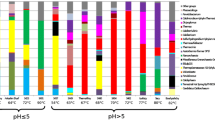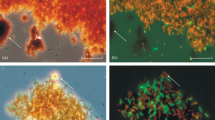Abstract
In this study, scanning electron microscopy (SEM) and 16S rRNA gene-based phylogenetic approach were applied to reveal the morphological structure and genetic diversity of thermophilic prokaryotic communities of a thermal karst well located in Budapest (Hungary). Bacterial and archaeal diversity of the well water (73.7 °C) and the biofilm developed on the inner surface of an outflow pipeline of the well were studied by molecular cloning method. According to the SEM images calcium carbonate minerals serve as a surface for colonization of bacterial aggregates. The vast majority of the bacterial and archaeal clones showed the highest sequence similarities to chemolithoautotrophic species. The bacterial clone libraries were dominated by sulfur oxidizer Thiobacillus (Betaproteobacteria) in the water and Sulfurihydrogenibium (Aquificae) in the biofilm. A relatively high proportion of molecular clones represented genera Thermus and Bellilinea in the biofilm library. The most abundant phylotypes both in water and biofilm archaeal clone libraries were closely related to thermophilic ammonia oxidizer Nitrosocaldus and Nitrososphaera but phylotypes belonging to methanogens were also detected. The results show that in addition to the bacterial sulfur and hydrogen oxidation, mainly archaeal ammonia oxidation may play a decisive role in the studied thermal karst system.




Similar content being viewed by others
References
Aguiar P, Beveridge TJ, Reysenbach AL (2004) Sulfurihydrogenibium azorense, sp. nov., a thermophilic hydrogen-oxidizing microaerophile from terrestrial hot springs in the Azores. Int J Syst Evol Microbiol 54:33–39
Alföldi L, Bélteky L, Böcker T, Horváth J, Korim K, Liebe P, Rémi R (eds) (1968) Budapest Hévizei (Thermal waters of Budapest). Vituki, Budapest 365
Altschul SF, Madden TL, Schaeffer AA, Zhang J, Zhang Z, Miller W, Lipman DJ (1997) Gapped BLAST and PSI-BLAST: a new generation of protein database search programs. Nucleic Acids Res 25:3389–3402
Anda D, Büki G, Krett G, Makk J, Márialigeti K, Erőss A, Mádl-Szőnyi J, Borsodi AK (2014) Diversity and morphological structure of bacterial communities inhabiting the Diana-Hygieia thermal spring (Budapest, Hungary). Acta Microbiol Immnol Hung 61:329–346
Ashelford KE, Chuzhanova NA, Fry JC, Jones AJ, Weightman AJ (2006) New screening software shows that most recent large 16S rRNA gene clone libraries contain chimeras. Appl Environ Microbiol 72:5734–5741
Baker GC, Smith JJ, Cowan DA (2003) Review and re-analysis of domain-specific 16S primers. J Microbiol Meth 55:541–555
Balkwill DL, Kieft TL, Tsukuda T, Kostandarithes HM, Onstott TC, Macnaughton S, Bownas J, Fredrickson JK (2004) Identification of iron-reducing Thermus strains as Thermus scotoductus. Extremophiles 8:37–44
Bennett PC, Engel AS (2005) Microbial contributions to karstification. In: Gadd GM, Semple KT, Lappin-Scott HM (eds) Microorganisms and earth systems. Advances in Geomicrobiology. Society for General Microbiology (SGM) Symposium 65. Cambridge University Press, Cambridge. pp 345–363
Blank CE, Cady SL, Pace NR (2002) Microbial composition of near-boiling silica-depositing thermal springs throughout Yellowstone National Park. Appl Environ Microbiol 68:5123–5135
Borsodi AK, Knáb M, Krett G, Makk J, Márialigeti K, Erőss A, Mádl-Szőnyi J (2012) Biofilm bacterial communities inhabiting the cave walls of the Buda Thermal Karst System, Hungary. Geomicrobiol J 29:611–627
Boston PJ, Spilde MN, Northup DE, Curry MD, Melim LA, Rosales-Lagarde L (2009) Microorganisms as speleogenetic agents: geochemical diversity but geomicrobial unity. In: Klimchouk A, Ford D (eds) Hypogene speleogenesis and karst hydrogeology of artesian basins. Special Paper 1. Ukrainian Institute of Speleology and Karstology, Simferopol, Ukraine, pp 51–58
Costa KC, Navarro JB, Shock EL, Zhang CL, Soukup D, Hedlund BP (2009) Microbiology and geochemistry of great boiling and mud hot springs in the United States Great Basin. Extremophiles 13:447–459
de la Torre JR, Walker CB, Ingalls AE, Könneke M, Stahl DA (2008) Cultivation of a thermophilic ammonia-oxidizing archaeon synthesizing crenarchaeol. Environ Microbiol 10:810–818
Déri-Takács J, Erőss A, Kovács J (2015) The chemical characterization of the thermal waters in Budapest. Environ Earth Sci, Hungary by using multivariate exploratory techniques. doi:10.1007/s12665-014-3904-3
Dodsworth JA, Hungate BA, Hedlund BP (2011) Ammonia oxidation, denitrification and dissimilatory nitrate reduction to ammonium in two US Great Basin hot springs with abundant ammonia-oxidizing archaea. Env Microbiol 13(8):2371–2386
Eaton AD, Clesceri LS, Rice EW, Greenberg AE, Franson MAH (eds) (2005) Standard methods for the examination of water and wastewater, 21st edn. American Public Health Association, Washington DC
Eder W, Huber R (2002) New isolates and physiological properties of the Aquificales and description of Thermocrinis albus sp. nov. Extremophiles 6:309–318
Edwards TA, Calica NA, Huang DA, Manoharan N, Hou W, Huang L, Panosyan H, Dong H, Hedlund BP (2013) Cultivation and characterization of thermophilic Nitrospira species from geothermal springs in the US Great Basin, China, and Armenia. FEMS Microbiol Ecol 85:283–292
Ehrlich HL (2002) Geomicrobiology, 4th edn. Marcel Dekker, New York 122
Erguder TH, Boon N, Wittebolle L, Marzorati M, Verstraete W (2009) Environmental factors shaping the ecological niches of ammonia-oxidizing archaea. FEMS Microbiol Rev 33:855–869
Erőss A, Mádl-Szőnyi J, Surbeck H, Horváth Á, Goldscheider N, Csoma AÉ (2012) Radionuclides as natural tracers for the characterization of fluids in regional discharge areas, Buda Thermal Karst, Hungary. J Hydrol 426–427:124–137
Everroad RG, Otaki H, Matsuura K, Haruta S (2012) Diversification of bacterial community composition along a temperature gradient at a thermal spring. Microbes Environ 27:374–381
Goldscheider N, Mádl-Szőnyi J, Erőss A, Schill E (2010) Review: thermal water resources in carbonate rock aquifers. Hydrogeol J 18:1303–1318
Grégoire P, Bohli M, Cayol JL, Joseph M, Guasco S, Dubourg K, Cambar J, Michotey V, Bonin P, Fardeau ML, Ollivier B (2011) Caldilinea tarbellica sp. nov., a filamentous, thermophilic, anaerobic bacterium isolated from a deep hot aquifer in the Aquitaine Basin. Int J Syst Evol Microbiol 61:1436–1441
Hirayama H, Takai K, Inagaki F, Yamato Y, Suzuki M, Nealson KH, Horikoshi K (2005) Bacterial community shift along a subsurface geothermal water stream in a Japanese gold mine. Extremophiles 9:169–184
Horikoshi K, Antranikian G, Bull AT, Robb FT, Stetter KO (eds) (2011) Extremophiles handbook. Springer, Berlin 1084
Huang Z, Hedlund BP, Wiegel J, Zhou J, Zhang CL (2007) Molecular phylogeny of uncultivated Crenarchaeota in Great Basin hot springs of moderately elevated temperature. Geomicrobiol J 24:535–542
Kim OS, Cho YJ, Lee K, Yoon SH, Kim M, Na H, Park SC, Jeon YS, Lee JH, Yi H, Won S, Chun J (2012) Introducing EzTaxon-e: a prokaryotic 16S rRNA Gene sequence database with phylotypes that represent uncultured species. Int J Syst Evol Microbiol 62:716–721
Kimura M (1980) A simple method for estimating evolutionary rates of base substitutions through comparative studies of nucleotide sequences. J Mol Evol 16:111–120
Kimura H, Sugihara M, Yamamoto H, Patel BKC, Kato K, Hanada S (2005) Microbial community in a geothermal aquifer associated with the subsurface of the Great Artesian Basin, Australia. Extremophiles 9:407–414
Könneke M, Bernhard AE, de la Torre JR, Walker CB, Waterburry JB, Stahl DA (2005) Isolation of an autotrophic ammonia-oxidizing marine archaeon. Nature 437:543–546
Kristjánsson JK, Hjörleifsdóttir S, Marteinsson VTH, Alfredsson GA (1994) Thermus scotoductus, sp. nov., a pigment-producing thermophilic bacterium from hot tap Water in Iceland and including Thermus sp. X-1. Syst Appl Microbiol 17:44–50
Kuzmann E, Homonnay Z, Kovács K, Zsabka P, Erőss A, Mádl-Szőnyi J (2014) Mössbauer study of biofilms formed at spring caves of Buda Karst, Hungary. Hyperfine Interact 226:571–577
Lane DJ (1991) 16S/23S rRNA sequencing. In: Stackebrandt E, Goodfellow M (eds) Nucleic acid techniques in bacterial systematics. Wiley, New York, pp 115–149
Marks CR, Stevenson BS, Rudd S, Lawson PA (2012) Nitrospira-dominated biofilm within a thermal artesian spring: a case for nitrification-driven primary production in a geothermal setting. Geobiology 10:457–466
Martin AM (1993) Isolation and characterization of Bacillus stearothermophilus strains from a thermal well of the upper-trias warm water system in the region of Budapest (Hungary). Acta Bot H 38:227–235
Massol-Deya AA, Odelson DA, Hickey RF, Tiedje JM (1995) Bacterial community fingerprinting of amplified 16S and 16–23S ribosomal DNA sequences and Restriction Endonuclease Analysis (ARDRA). Kluwer Academic Publishersm, Dordrecht, pp 3.3.2:1–3.3.2:8
Messing J (1983) New M13 vectors for cloning. Meth Enzymol 101:20–78
Miroshnichenko ML, Lebedinsky AV, Chernyh NA, Tourova TP, Kolganova TV, Spring S, Bonch-Osmolovskaya EA (2009) Caldimicrobium rimae gen. nov., sp. nov., an extremely thermophilic, facultatively lithoautotrophic, anaerobic bacterium from the Uzon Caldera, Kamchatka. Int J Syst Evol Microbiol 59:1040–1044
Miseta R, Palatinszky M, Makk J, Márialigeti K, Borsodi AK (2012) Phylogenetic diversity of bacterial communities associated with sulfurous karstic well waters of a Hungarian spa. Geomicrobiol J 29:101–113
Nakagawa S, Shtaih Z, Banta A, Beveridge TJ, Sako Y, Reysenbach A-L (2005) Sulfurihydrogenibium yellowstonense sp. nov., and extremely thermophilic, facultative heterotrophic, sulfur-oxidizing bacterium from Yellowstone National Park, and emended descriptions of the genus Sulfurihydrogenibium, Sulfurihydrogenibium subterraneum and Sulfurihydrogenibium azorense. Int J Syst Evol Microbiol 55:2263–2268
Saitou N, Nei M (1987) The neighbor-joining method: a new method for reconstructing phylogenetic trees. Mol Biol Evol 4:406–425
Skirnisdottir S, Hreggvidsson GO, Holst O, Kristjansson JK (2001) Isolation and characterization of a mixotrophic sulfur-oxidizing Thermus scotoductus. Extremophiles 5:45–51
Stieglmeier M, Kling A, Alves RJE, Rittmann SKMR, Melcher M, Leisch N, Schleper C (2014) Nitrososphaera viennensis gen. nov., sp. nov., an aerobic and mesophilic, ammonia-oxidizing archaeon from soil and a member of the archaeal phylum Thaumarchaeota. Int J Syst Evol Microbiol 64:2738–2752
Tamura K, Stecher G, Peterson D, Filipski A, Kumar S (2013) MEGA6: molecular evolutionary genetics analysis version 6.0. Mol Biol Evol 30:2725–2729
Vick TJ, Dodsworth JA, Costa KC, Shock EL, Hedlund BP (2010) Microbiology and geochemistry of Little Hot Creek, a hot spring environment in the Long Valley Caldera. Geobiology 8:140–154
Whitman WB, Coleman DC, Wiebe WJ (1998) Prokaryotes: the unseen majority. Proc Natl Acad Sci 95:6578–6583
Wood AP, Kelly DP (1988) Isolation and physiological characterisation of Thiobacillus aquaesulis sp. nov., a novel facultatively autotrophic moderate thermophile. Arch Microbiol 149:339–343
Yamada T, Imachi H, Ohashi A, Harada H, Hanada S, Kamagata Y, Sekiguchi Y (2007) Bellilinea caldifistulae gen. nov., sp. nov. and Longilinea arvoryzae gen. nov., sp. nov., strictly anaerobic, filamentous bacteria of the phylum Chloroflexi isolated from methanogenic propionate-degrading consortia. Int J Syst Evol Microbiol 57:2299–2306
Yarza P, Yilmaz P, Pruesse E, Glöckner FO, Ludwig W, Schleifer KH, Whitman WB, Euzéby J, Amann R, Rosselló-Móra R (2014) Uniting the classification of cultured and uncultured bacteria and archaea using 16S rRNA gene sequences. Nature Rev Microbiol 12:635–645
Zhang CL, Ye Q, Huang Z, Li W, Chen J, Song Z, Zhao W, Bagwell C, Inskeep WP, Ross C, Gao L, Wiegel J, Romanek CS, Shock EL, Hedlund BP (2008) Global occurrence of archaeal amoA genes in terrestrial hot springs. Appl Environ Microbiol 74:6417–6426
Zhao W, Song Z, Jiang H, Li W, Mou X, Romanek CS, Wiegel J, Dong H, Zhang CL (2011) Ammonia-oxidizing archaea in Kamchatka Hot Springs. Geomicrobiol J 28:149–159
Acknowledgments
This research was supported by the Hungarian Scientific Research Fund (OTKA) Grant NK101356. We gratefully acknowledge the help of Dr. Éva Ács (MTA, Danube Research Institute) in the electron microscopic examinations.
Author information
Authors and Affiliations
Corresponding author
Additional information
Communicated by A. Oren.
Rights and permissions
About this article
Cite this article
Anda, D., Makk, J., Krett, G. et al. Thermophilic prokaryotic communities inhabiting the biofilm and well water of a thermal karst system located in Budapest (Hungary). Extremophiles 19, 787–797 (2015). https://doi.org/10.1007/s00792-015-0754-1
Received:
Accepted:
Published:
Issue Date:
DOI: https://doi.org/10.1007/s00792-015-0754-1




